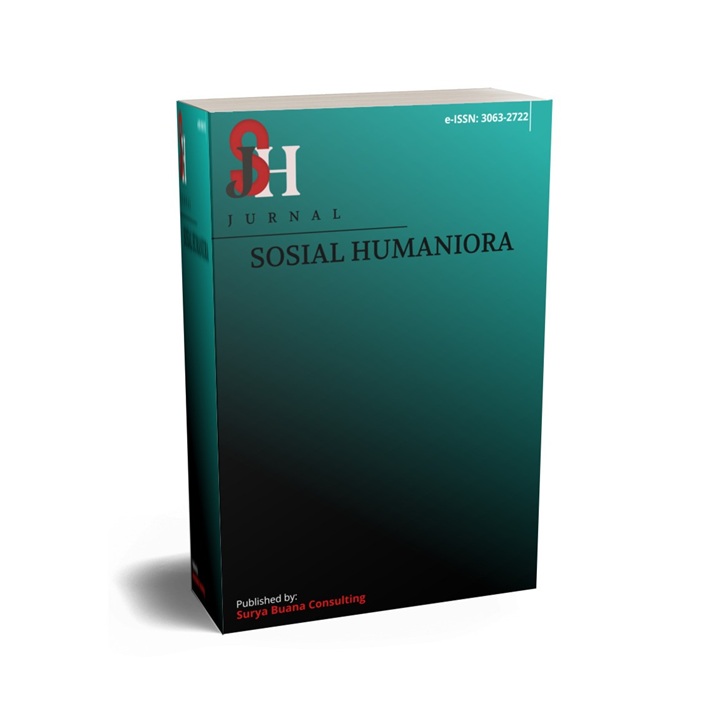Fenomena Mitologi Hari Futung dalam Konstruksi Sosial Komunitas Nelayan Tradisional di Pulau Alor
DOI:
https://doi.org/10.70214/233j1310Keywords:
Fenomena, mitologi, Hari Futung, konstuksi sosial, nelayan tradisionalAbstract
Hari Futung merupakan salasatu mahluk penunggu laut yang dipercaya oleh masyarakat pesisir Alor memiliki kekuatan dalam membantu masyarakat suku Alor apabila mengalami perbagai masalah atau musibah di laut. Penelitian ini diarahkan untuk bagaimana fenomena mitologi Hari Futung dalam kehidupan sosial masyarakat pesisir di Kecamatan Alor Barat Laut Kabupaten Alor yang dirumuskan dalam dua masalah pokok, yaitu: Makna mitologi Hari Futung bagi masyarakat pesisir di Kecamatan Alor Barat Laut Kabupaten Alor, dan kedudukan Hari Futung bagi aktifitas masyarakat pesisir di Kecamatan Alor Barat laut Kabupaten Alor. Tujuan dari penelitian ini melihat Fenomena Mitologi Hari Futung Dalam Konstuksi Sosial Masyarakat Nelayan Tradisionil Di Desa Alor Kecil Kecamatan Alor Barat Laut Kabupaten Alor dan Konstruksi Sosial atas Mitologi Hari Futung Pada Nelayan Tradisionil Pesisir Pulau Alor di di Desa Alor Kecil Kecamatan Alor Barat Laut Kabupaten Alor. Penelitian ini menggunakan jenis penelitian fenomenologi dalam pendekatan penelitian kualitatif, dimana informasi diperoleh dari pengelaman-pengalaman subjektif yang dialami oleh informen. Kesimpulan penelitian adalah 1. Mitologi Hari Futung dan laut Alor merupakan satu matarantai yang tidak terpisahkan dalam kehidupan sosial mereka. Hari Futung dimaknai sebagai mahluk laut yang menjadi menjadi pembuat masalah dilaut bagi melayan yang merusak ekosistem laut dan juga dapat menjadi penolong bagi nelayan yang tenggelam atau perahu karam di wilayah perairan laut Alor, sehingga diperlukan interaksi melalui rirual pao hari atau memberi makan nenek moyang laut yang telah terkonstruksi menjadi sebuah realitas subjektif maupun objektif sebagai sebuah kesadaran sosial pada tatanan adatiah dalam kehidupan sosial masyarakat pesisir diwilayah perairan laut Kabupaten Alor 2. Mitologi Hari Futung telah terkonstruksi dalam kehidupan sosial masyarakat nelayan pesisir pulau Alor pada kurun waktu yang panjang menjadi sebuah keyakinan, yang kemudian menyulitkan masyarakat beradaptasi dengan lingkungan yang berada diluar lingkungan sosial mereka dalam lingkaran rasionalisasi agama dam ilmu pengetahuan modern. Mitologi Hari Futung terkonstruksi dalam kehidupan sosial msyarakat nelayan pesisir Alor dalam lingkaran adatiah yang terbatas, terpisah dari lingkaran agama dan ilmu pengetahuan modern yang universal.
References
Clifford Geertz (1983) Islam Santri, Priyayi dan Abangan Terjemahan Bur Rasuanto Penerbit Dunia Pustaka Jaya Jakarta.
John W. Creswell, 2015. Penelitian Kualitatif dan Fesain Riset: Memilih diantara Lima Pendekatan, Pustaka Pelajar Jakarta.
Laode Monto Bauto, 2014, Perspektif Agama dan kebudyaan Dalam Kehidupan Masyarakat Indonesia, Suatu Tinjauan Sosiologi Agama Dalam Jurnal JPIS: Pendidikan dan Ilmu-Ilmu Sosial Vol. 23 No.7 Tahun 2014
Umi Hidayati, 2017. “INA” Perempuan Maluku dalam Bejana kehidupan. Artikel Budaya, Dikretorat Jendral Kebudayaan Kemendikbut Jakarta.
Peter L Belger dan Thomas Luckmann, Tapsir Sosial atas kenyataan risalah tentang Sosiologi Ilmu Pengetahuan
Syarifuddin Darajad, 2023, Konstruksi Sosial Atas Filosofi Jagung Beras Kita Di Dalam Laut
Sunarti, S. 2023. Tradisi Lisan Pou Hari dalam Pendekatan Ekokritik. Dalam E. N.
Suryani, I. 2014, Kearifan Lokal. Dalam jurnal Musawa Volume.13 Nomor.2
Yuri Rahayu, 2016, Kearifan Lokal Pantai Laut Selatan (Mitos Nyi Roro Kidul) Sebagai Desa Wisata Dan Asset Kabupaten Sukabumi dalam Jurnal Media Wisata, Volume 14, Nomor 2.
Yoseph Yapi Taum, 2013. Berbagai Mitos Tentang Laut: Mengungkap Konsep Bahari Bangsa Indonesia Artikel Kongres Internasional Folklore Asia III Hotel Inna Garuda, Yogyakarta.
Zainur Wula, 2020, Kapita Selekta Teori-Teori Sosial Literacy Institut Kota Kendari.
Downloads
Published
Issue
Section
License
Copyright (c) 2025 Syarifuddin Darajad, Zainur Wula (Author)

This work is licensed under a Creative Commons Attribution-ShareAlike 4.0 International License.
Penulis yang menerbitkan karyanya di jurnal ini menyetujui ketentuan berikut.
1. Penulis memegang hak cipta dan memberikan jurnal hak penerbitan pertama dengan karya yang dilisensikan secara bersamaan di bawah Lisensi Internasional Creative Commons Atribusi-BerbagiSerupa 4.0 . yang memungkinkan orang lain untuk berbagi karya tersebut dengan pengakuan atas kepengarangan karya dan penerbitan awal dalam jurnal ini.
2. Penulis dapat membuat pengaturan kontraktual terpisah dan tambahan untuk distribusi non-eksklusif versi terbitan jurnal dari suatu karya (misalnya, mengunggahnya ke repositori institusi atau menerbitkannya dalam sebuah buku), dengan pengakuan penerbitan awal dalam jurnal ini.
3. Penulis diizinkan dan didorong untuk mengunggah karya mereka secara daring (misalnya, di repositori institusi atau di situs web mereka) sebelum dan selama proses penyerahan, karena hal ini dapat mengarah pada pertukaran yang produktif, serta kutipan yang lebih awal dan lebih banyak dari karya yang diterbitkan (Lihat Dampak Akses Terbuka).




:strip_icc():format(webp)/kly-media-production/medias/4550198/original/016488700_1692862388-cover.jpg)












.png?raw=true)
.png?raw=true)
